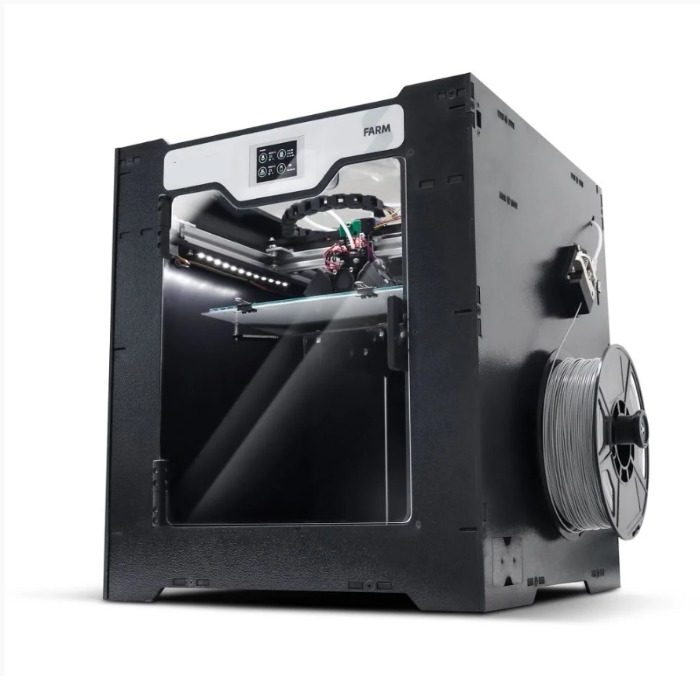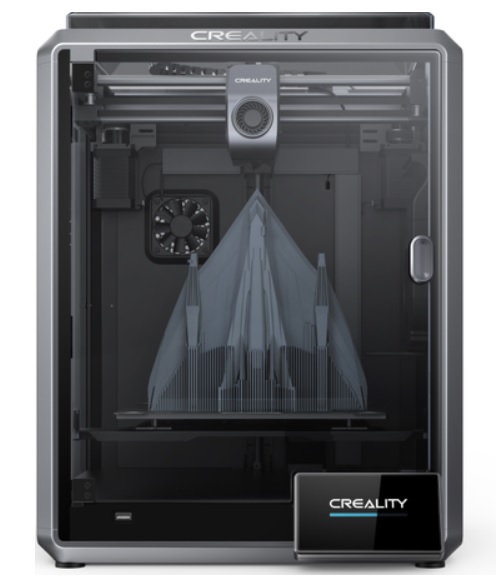Compare FARM vs K1
Comparison between the best 3D printers
Choose the best 3D printer at the best price. The cheapest 3D printers are here.
Buy a 3D printer here with 3D Fila.
 |
 |
|
| Model | FARM |
K1[BUY K1] |
| Printing Material | Filament | Filament |
| Buy Filament for Sethi 3D FARM | Buy Filament forCreality 3D K1 | |
| Estimated price | $1127,00 | $399,00 |
| Manufacturer | Sethi 3D | Creality 3D |
| Release Year | 2021 | 2023 |
| Print Volume [mm] | 240x240x240 | 220x220x250 |
| Printer Size [mm] | 550x42x500 | 355x355x480 |
| Weight [kg] | 15,7 | 12,5 |
| Power Loss Recovery | YES | YES |
| Enclosed printer | YES | YES |
| Bed Leveling | Automatic | Automatic |
| Filament End Sensor | YES | YES |
| Bed type | Heated | Heated |
| Power supply system | Bowden | Direct Drive |
| Standard nozzle | 0,4 | 0,4 |
| Maximum Nozzle Temperature [°C] | 270 | 300 |
| Maximum Bed Temperature [°C] | 120 | 120 |
| Maximum printing speed [mm/s] | 80 | 600 |
| Filament holder | YES | YES |
| Camera for supervision | NO | NO |
| Recommended filaments | PLA, PETG, Tritan, Flex, ABS | ABS, PLA, PETG, PET, TPU, PA, ABS, ASA, PC, PLA-CF, PA-CF, PET-CF |
| Recommended slicers | Cura, Simplify, Slic3r | Creality Print; Cura, Simplify3D e PrusaSlicer |
| Maximum Resolution [mm] | 0,1 | |
| Processor | ||
| Display | Touchscreen TFT | Display touchscreen 4,3'' |
| Power Supply | 450 W | 110/220V / 350W |
| Connectivity | USB | Ethernet / USB / Wi-Fi |
| Operating systems | Windows, Mac, Linux | Windows, Mac, Linux |
| Date of registration in the system | 2022-10-11 | 2023-04-17 |
| Release date | 2021 | 2023 |
| Extra features | Sethis Farm printer offers a generous 240 x 240 x 240 mm print area, ideal for large projects. Its intuitive touchscreen display makes it easy to operate, while the intelligent sensor prevents problems by detecting filament shortages or jams. Its power recovery feature allows you to resume printing after interruptions. It stands out for its 9-point optical auto-leveling and high-performance heated bed, ensuring accuracy and versatility on different materials. Its 32-bit electronics and silent drivers promote a smooth and efficient experience. In addition, the Farm has a closed cabinet, expanding the range of usable polymers, and a turbo cooling system to speed up the process between prints. The machine also offers practicality with a storage drawer and simplified software updates. | The K1 is an extremely fast FDM 3D printer, reaching 600mm/s, 12 times faster than standard models. Equipped with a Core XY system and lightweight print head, it offers energy efficiency and high print quality. It stands out for its dual-gear extruder and quickly heated hotend, as well as dual cooling to prevent warping. Its robust structure ensures stability at high speed, with optimized software to speed up the printing process. |
| Support for multiple colors and materials (AMS and CFS) | NO | NO |
Notes * |
||
| Cost-benefit | 6 / 10 | 8 / 10 |
| Hardware | 3 / 10 | 4.8 / 10 |
| Tela | . | . |
| Print volume | 3 / 10 | 3 / 10 |
| Performance | 0 / 10 | 5 / 10 |
| [BUY K1] |
Conclusion |
| ### Conclusion When comparing the two 3D printers, the FARM from Sethi 3D and the K1 from Creality 3D, several factors emerge that highlight their respective strengths and weaknesses. The FARM, despite its higher price, offers a larger print volume, robust construction, and features that cater to versatility in material usage, which can be valuable for users focused on diverse projects. Its advanced auto-leveling system and power loss recovery enhance user experience, ensuring reliable prints. However, its overall performance, particularly in speed, is relatively slower, reflecting a trade-off for stability and build volume. On the other hand, the K1 stands out for its remarkable printing speed, making it an ideal choice for those who prioritize efficiency and high throughput. Its modern design, including features like dual-gear extruder and rapid heating, enhances print quality while reducing waiting times. Although its print volume is slightly smaller, it compensates with optimized structure and software, making it suitable for users who need fast production but can work within a smaller scale. In terms of cost-effectiveness, the K1 offers a better value proposition with a higher cost-benefit rating and superior performance at its price point, making it an attractive option for those conscious of budget without sacrificing speed. The FARM, while more expensive, provides a solid performance for users needing larger prints and a broader range of compatible materials. Ultimately, the choice between these two printers should be guided by specific user needs—whether that be speed and efficiency with the K1 or versatility and larger build space with the FARM. |

